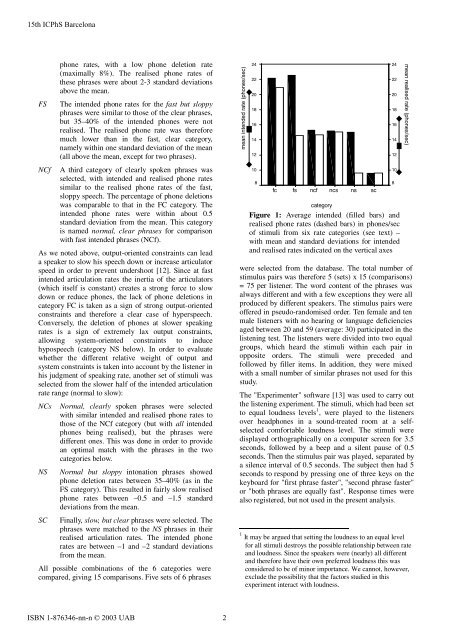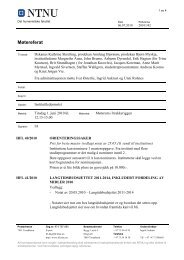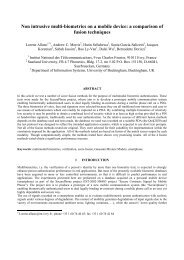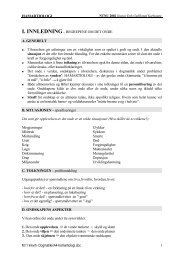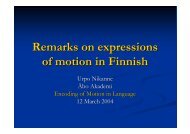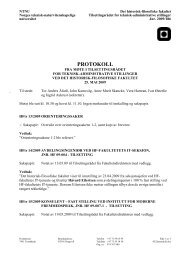The perception of articulation rate
The perception of articulation rate
The perception of articulation rate
You also want an ePaper? Increase the reach of your titles
YUMPU automatically turns print PDFs into web optimized ePapers that Google loves.
FS<br />
NCf<br />
phone <strong>rate</strong>s, with a low phone deletion <strong>rate</strong><br />
(maximally 8%). <strong>The</strong> realised phone <strong>rate</strong>s <strong>of</strong><br />
these phrases were about 2-3 standard deviations<br />
above the mean.<br />
<strong>The</strong> intended phone <strong>rate</strong>s for the fast but sloppy<br />
phrases were similar to those <strong>of</strong> the clear phrases,<br />
but 35–40% <strong>of</strong> the intended phones were not<br />
realised. <strong>The</strong> realised phone <strong>rate</strong> was therefore<br />
much lower than in the fast, clear category,<br />
namely within one standard deviation <strong>of</strong> the mean<br />
(all above the mean, except for two phrases).<br />
A third category <strong>of</strong> clearly spoken phrases was<br />
selected, with intended and realised phone <strong>rate</strong>s<br />
similar to the realised phone <strong>rate</strong>s <strong>of</strong> the fast,<br />
sloppy speech. <strong>The</strong> percentage <strong>of</strong> phone deletions<br />
was comparable to that in the FC category. <strong>The</strong><br />
intended phone <strong>rate</strong>s were within about 0.5<br />
standard deviation from the mean. This category<br />
is named normal, clear phrases for comparison<br />
with fast intended phrases (NCf).<br />
As we noted above, output-oriented constraints can lead<br />
a speaker to slow his speech down or increase articulator<br />
speed in order to prevent undershoot [12]. Since at fast<br />
intended <strong>articulation</strong> <strong>rate</strong>s the inertia <strong>of</strong> the articulators<br />
(which itself is constant) creates a strong force to slow<br />
down or reduce phones, the lack <strong>of</strong> phone deletions in<br />
category FC is taken as a sign <strong>of</strong> strong output-oriented<br />
constraints and therefore a clear case <strong>of</strong> hyperspeech.<br />
Conversely, the deletion <strong>of</strong> phones at slower speaking<br />
<strong>rate</strong>s is a sign <strong>of</strong> extremely lax output constraints,<br />
allowing system-oriented constraints to induce<br />
hypospeech (category NS below). In order to evaluate<br />
whether the different relative weight <strong>of</strong> output and<br />
system constraints is taken into account by the listener in<br />
his judgment <strong>of</strong> speaking <strong>rate</strong>, another set <strong>of</strong> stimuli was<br />
selected from the slower half <strong>of</strong> the intended <strong>articulation</strong><br />
<strong>rate</strong> range (normal to slow):<br />
NCs Normal, clearly spoken phrases were selected<br />
with similar intended and realised phone <strong>rate</strong>s to<br />
those <strong>of</strong> the NCf category (but with all intended<br />
phones being realised), but the phrases were<br />
different ones. This was done in order to provide<br />
an optimal match with the phrases in the two<br />
categories below.<br />
NS<br />
SC<br />
Normal but sloppy intonation phrases showed<br />
phone deletion <strong>rate</strong>s between 35–40% (as in the<br />
FS category). This resulted in fairly slow realised<br />
phone <strong>rate</strong>s between –0.5 and –1.5 standard<br />
deviations from the mean.<br />
Finally, slow, but clear phrases were selected. <strong>The</strong><br />
phrases were matched to the NS phrases in their<br />
realised <strong>articulation</strong> <strong>rate</strong>s. <strong>The</strong> intended phone<br />
<strong>rate</strong>s are between –1 and –2 standard deviations<br />
from the mean.<br />
All possible combinations <strong>of</strong> the 6 categories were<br />
compared, giving 15 comparisons. Five sets <strong>of</strong> 6 phrases<br />
mean intended <strong>rate</strong> (phones/sec)<br />
24<br />
22<br />
20<br />
18<br />
16<br />
14<br />
12<br />
10<br />
8<br />
fc<br />
fs<br />
ncf<br />
category<br />
were selected from the database. <strong>The</strong> total number <strong>of</strong><br />
stimulus pairs was therefore 5 (sets) x 15 (comparisons)<br />
= 75 per listener. <strong>The</strong> word content <strong>of</strong> the phrases was<br />
always different and with a few exceptions they were all<br />
produced by different speakers. <strong>The</strong> stimulus pairs were<br />
<strong>of</strong>fered in pseudo-randomised order. Ten female and ten<br />
male listeners with no hearing or language deficiencies<br />
aged between 20 and 59 (average: 30) participated in the<br />
listening test. <strong>The</strong> listeners were divided into two equal<br />
groups, which heard the stimuli within each pair in<br />
opposite orders. <strong>The</strong> stimuli were preceded and<br />
followed by filler items. In addition, they were mixed<br />
with a small number <strong>of</strong> similar phrases not used for this<br />
study.<br />
<strong>The</strong> "Experimenter" s<strong>of</strong>tware [13] was used to carry out<br />
the listening experiment. <strong>The</strong> stimuli, which had been set<br />
to equal loudness levels 1 , were played to the listeners<br />
over headphones in a sound-treated room at a selfselected<br />
comfortable loudness level. <strong>The</strong> stimuli were<br />
displayed orthographically on a computer screen for 3.5<br />
seconds, followed by a beep and a silent pause <strong>of</strong> 0.5<br />
seconds. <strong>The</strong>n the stimulus pair was played, sepa<strong>rate</strong>d by<br />
a silence interval <strong>of</strong> 0.5 seconds. <strong>The</strong> subject then had 5<br />
seconds to respond by pressing one <strong>of</strong> three keys on the<br />
keyboard for "first phrase faster", "second phrase faster"<br />
or "both phrases are equally fast". Response times were<br />
also registered, but not used in the present analysis.<br />
ncs<br />
Figure 1: Average intended (filled bars) and<br />
realised phone <strong>rate</strong>s (dashed bars) in phones/sec<br />
<strong>of</strong> stimuli from six <strong>rate</strong> categories (see text) –<br />
with mean and standard deviations for intended<br />
and realised <strong>rate</strong>s indicated on the vertical axes<br />
1 It may be argued that setting the loudness to an equal level<br />
for all stimuli destroys the possible relationship between <strong>rate</strong><br />
and loudness. Since the speakers were (nearly) all different<br />
and therefore have their own preferred loudness this was<br />
considered to be <strong>of</strong> minor importance. We cannot, however,<br />
exclude the possibility that the factors studied in this<br />
experiment interact with loudness.<br />
ns<br />
sc<br />
24<br />
22<br />
20<br />
18<br />
16<br />
14<br />
12<br />
10<br />
8<br />
mean realised <strong>rate</strong> (phones/sec)


